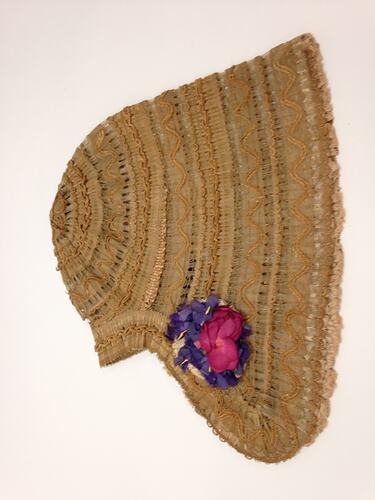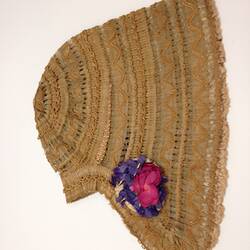Summary
Straw bonnet of a style worn in England around 1846 to 1860. It has a deep brim to shelter the face, reflecting the Victorian era's emphasis on modesty and propriety after Queen Victoria's ascension to the throne in 1837, as well as providing effective shade for the face. The bonnet has remnant ribbon on the inside - it was not uncommon in the late 1840s/early 1850s for bonnets to have fixings attached on the inside (Marion Fletcher, 'Costume in Australia 1788-1901', 1984), although the mauve colour of the ribbon suggests it was added later, perhaps in the late 1850s when mauve became popular.
According to the donor, the bonnet was worn by Elizabeth Harris, an immigrant from Staffordshire, England, who spent her later life in Melbourne. Elizabeth married John Astle, from Yorkshire and they migrated to Victoria in 1854. They had one daughter. John was a publican from 1861 until he died in 1874. A John Astle is listed in the 1865 Sands & McDougall Post Office Directory as being at the Emu Hotel, 117 Bouverie Street, Carlton. In 1870 a John Astle is at the Staffordshire Arms Hotel, corner of Oxford and Blackwood Streets, Hotham (later North Melbourne). In 1875, after he had passed away, Mrs John Astle is recorded at this address, suggesting that Elizabeth was resident and possibly publican. She re-married in late 1876 and died at Summer Hill, Mount Alexander Road, Moonee Ponds, aged 85.
The ribbon may have been coloured with one of the methyl violet and aniline blue families of dyes which became fashionable in the decades following the discovery of 'aniline violet', aka 'mauve' or 'mauveine', by William Perkin in London in 1856. Before that, purple was an expensive dye made from murex snail shells, and was a sign of social status.
Physical Description
Cream straw bonnet with wide, long brim. Includes very fine staw, woven in sections. Remnants of pink and purple cloth flowers with green details on right and left side, corresponding to remnant purple fixings on the inside that would have been ribbons for securing under the chin. They have been simply attached with large stitches, perhaps added or replaced at a later date. A small, separate piece of chin ribbon remains.
Significance
The bonnet and shoes are particularly significant as rare surviving examples of clothing believed to have been worn in Melbourne in the early gold rush years. They may have been brought to Australia by English migrant Elizabeth Astle of Staffordshire. Elizabeth is likely to have been part of the growing middle class: she married a hotel keeper and purchased two pairs of similar shoes (of which the two shoes are the single survivors) which were probably fairly expensive. Certainly she would not have expected them to last long, yet the patterns of wear suggest that they were little used. The bonnet is of a more basic construction and materials, but its original decoration may have been more elaborate.
The date of the bonnet and shoes indicates that Elizabeth would have bought them a few years before or after her migration. Retailers in Melbourne in the years after her migration frequently advertised the arrival of ships carrying particular goods - for instance, William Watson & Sons of Flinders-street east (they also a branch in London) advertised in the Argus on 25 February 1854 the arrival of straw bonnets, shoes and a large range of other clothing items. Although the bonnet and shoes are more likely to have been made in England and/or France (the donor believes the shoes to be French) local clothing manufacturing was developing at the time - for instance, on 24 January 1856 'King' of 122 Brunswick-street Collingwood was advertising for 'straw-bonnet makers', and local shoe and slipper makers were also in demand. It is therefore not impossible that at least one of these objects was made locally during the gold rush, further adding to its significance.
More Information
-
Collecting Areas
Clothing & Textiles, Migration & Cultural Diversity, Home & Community
-
Acquisition Information
Donation from Ms Kay Sharples - Museum Victoria, 2014
-
Original Owner
-
Classification
-
Category
-
Discipline
-
Type of item
-
References
Marion Fletcher, 1984. Costume in Australia 1788-1901. Melbourne: OUP, p.102 Victoria and Albert Museum web site [Link 1] accessed 12/11/2014 The Argus, 4 September 1861, 27 September 1865, 9 Sep 1870, 1 Jan 1877 and 17 May 1910 Bendigo Advertiser, 6 May 1865 Ancestry, Sutcliffe and Anderson family trees, accessed 12 Nov 2014. 'Mauvine', Science Museum, London, [Link 2] accessed 4 March 2021.
-
Keywords



